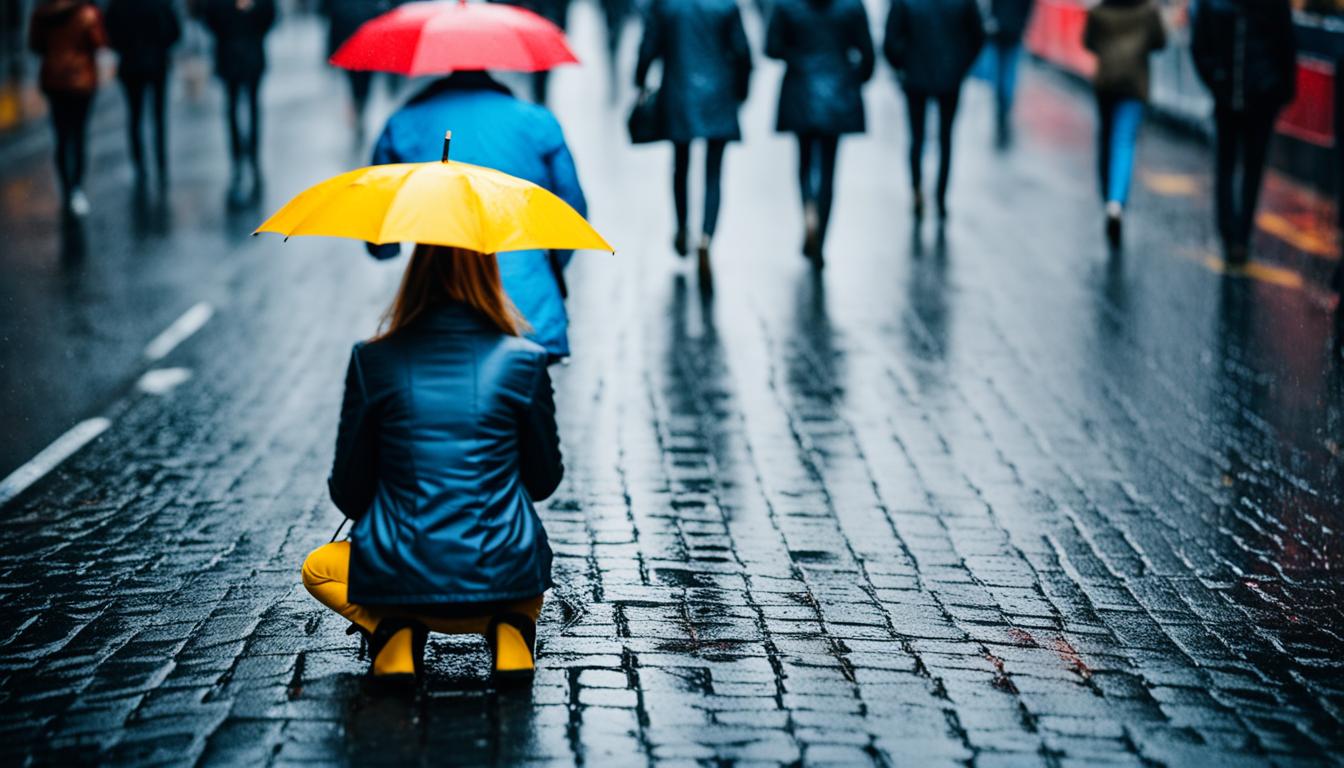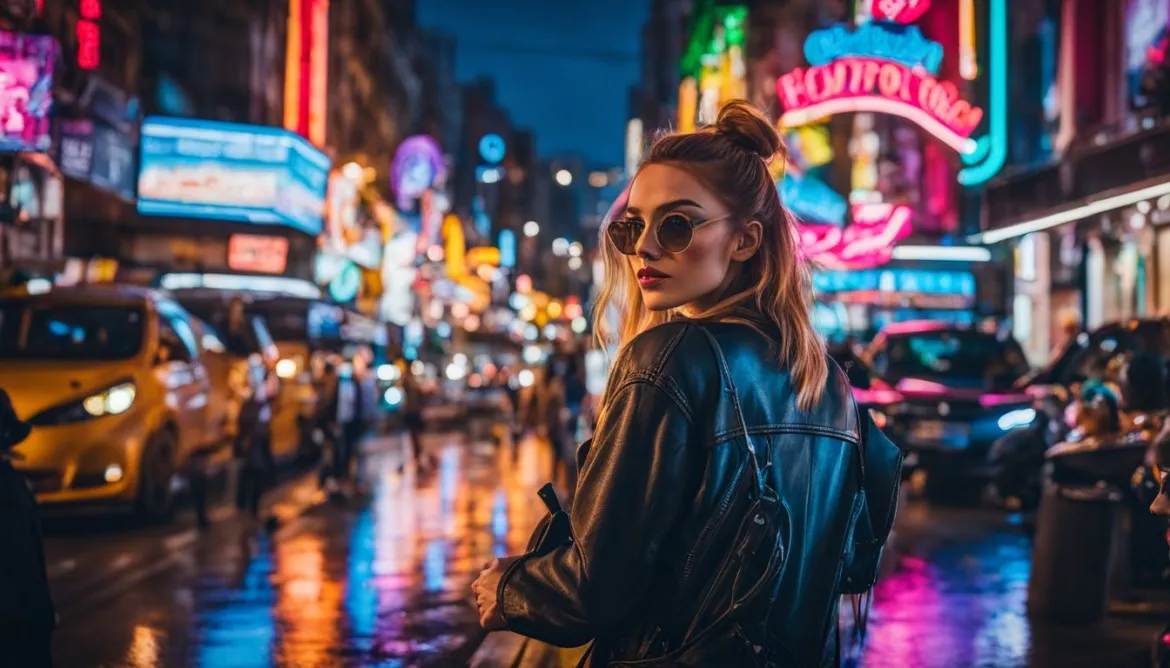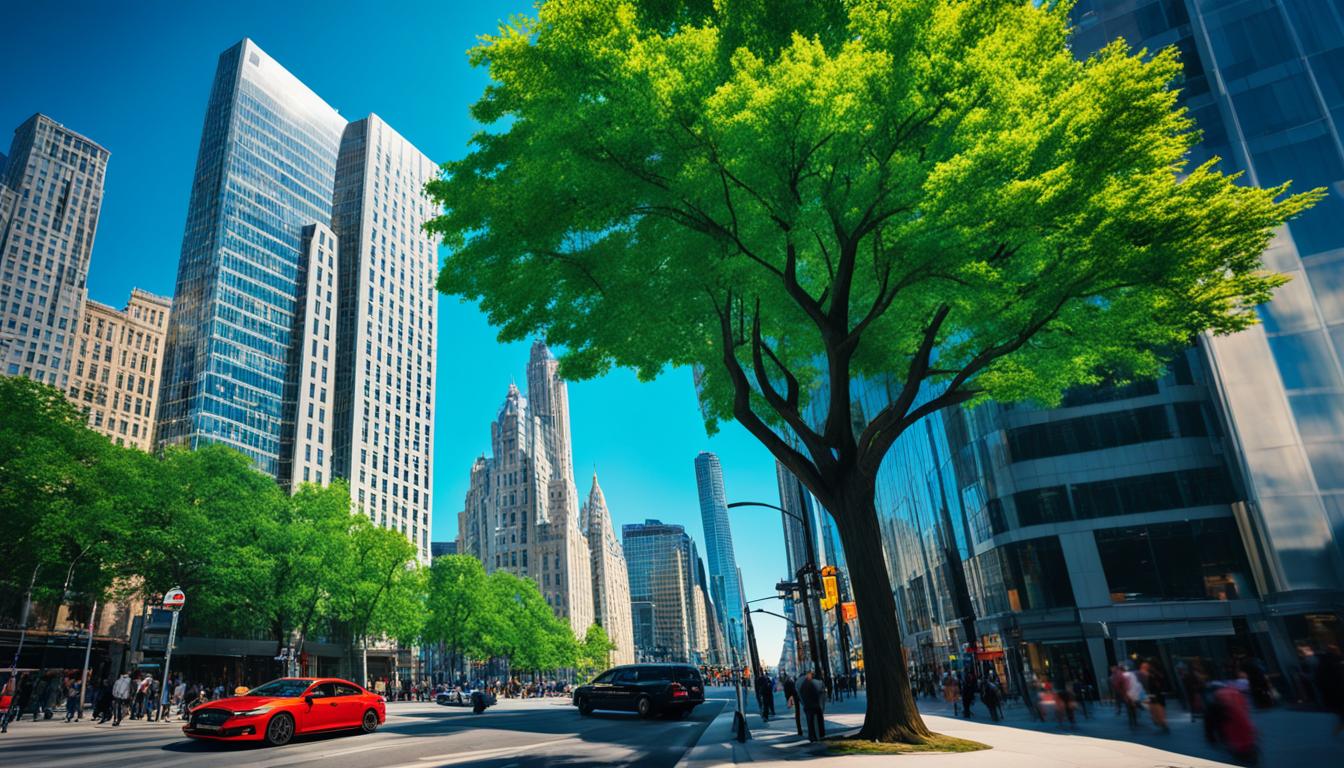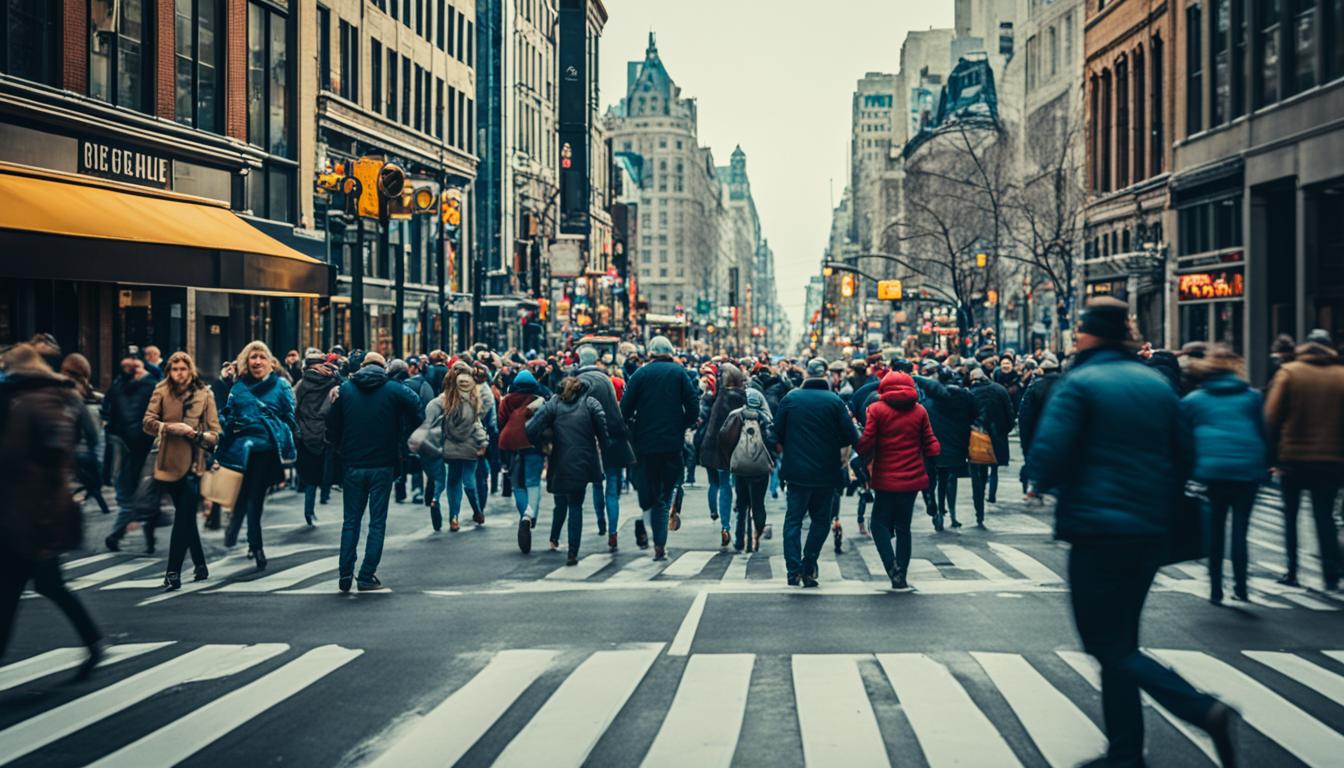When it comes to street photography, the weather and changing seasons can have a significant impact on the mood, narrative, and composition of our shots. Different weather conditions and seasons offer unique opportunities for capturing compelling street scenes that tell stories and evoke emotions. Understanding the influence of weather and seasons in street photography can help us adapt to the ever-changing conditions and create powerful images that resonate with viewers.
Whether it’s the soft light of a misty morning, the vibrant colors of autumn foliage, or the dramatic shadows cast by a stormy sky, weather conditions play a crucial role in shaping the atmosphere and visual elements of our photographs. Each season brings its own distinctive characteristics, textures, and colors, providing street photographers with a diverse range of compositions to explore.
Capturing street scenes in different weather conditions allows us to showcase the beauty and rawness of everyday life. Rain-soaked streets can create a sense of mystery and romance, while snow-covered landscapes can transform familiar scenes into enchanting winter wonderlands. Adjusting our photography techniques and embracing the weather can lead to unique and striking images that capture the essence of a particular moment in time.
Key Takeaways:
- Weather and seasons have a significant influence on the mood and narrative of street photography.
- Adapting to different weather conditions allows us to capture unique and evocative street scenes.
- Each season offers its own visual elements and compositions that enhance street photography.
- From sunlight to rain, fog to snow, weather conditions provide distinctive atmospheres for our photographs.
- Capturing street scenes in different weather conditions helps us convey the beauty and authenticity of everyday life.
The Impact of Weather on Street Photography
Weather conditions have a significant impact on street photography, shaping the overall mood and atmosphere of captured images. Each weather element, whether it’s the soft sunlight of a clear day, the dramatic raindrops falling, the mystic fog enveloping the streets, or the serene snow covering the urban landscape, brings its own unique character to street photographs. Street photographers must learn to adapt to different weather conditions and employ them to their advantage in order to create compelling and evocative images.
Let’s explore how various weather conditions can influence street photography and provide tips for capturing stunning images in different weather scenarios. From the warm hues of sunlight to the wet reflections on rainy streets, each weather condition offers its own distinct visual narrative.
Sunlight: Harnessing the Power of Natural Light
When shooting in sunlight, it’s essential to consider the direction and intensity of light to create dynamic compositions. The golden hour, which occurs during sunrise and sunset, offers soft, warm light that can enhance textures and create dramatic shadows. Play with silhouettes, use the long shadows to your advantage, and experiment with dynamic compositions to make the most of the sunlight’s impact on your street photography.
Rain: Unveiling Reflections and Emotions
The rain brings a unique and moody atmosphere to street photography. Use the wet surfaces to your advantage by capturing reflections, whether it’s the city lights reflected on the wet pavement or the blurred figures sheltering themselves under umbrellas. Embrace the unpredictable nature of rain and let it add an additional layer of storytelling and emotion to your images.
Fog: Embracing the Mystery and Serenity
Foggy weather creates a mysterious and ethereal atmosphere, perfect for capturing unique street scenes. Look for scenes where buildings disappear in the mist, subjects emerge abruptly from the fog, or light illuminates the density of the fog itself. The limited visibility and diffusion of light can create a sense of serenity and intrigue in your street photographs.
Snow: Transforming the Urban Landscape
The gentle touch of snow can completely transform an urban landscape, adding a sense of purity and tranquility to street photographs. Embrace the contrasting tones between the white snow and the darker elements of the scene. Look for scenes with footprints in the snow, people braving the cold, or the colorful warmth of street lights shining through the winter night.
Remember, weather conditions are ever-changing, and embracing these changes can lead to unique and captivating street photographs. Adapt your techniques, experiment with compositions, and let the weather guide your creative vision. By understanding how weather impacts street photography and utilizing it to its full potential, you can create stunning images that capture the essence of the moment.
| Weather Condition | Tips |
|---|---|
| Sunlight |
|
| Rain |
|
| Fog |
|
| Snow |
|
Seasonal Changes and Street Photography
The changing seasons offer street photographers a wealth of opportunities to capture unique and compelling images. Each season brings its own distinct atmosphere, colors, and elements that can enhance street photographs and tell captivating visual stories. Whether it’s the vibrant colors of spring, the sunny days of summer, the golden tones of autumn, or the serene landscapes of winter, every season offers a wealth of inspiration for street photography composition.
During spring, when nature awakens from its winter slumber, streets burst with life. Blooming flowers and greenery provide a vibrant backdrop for capturing energetic street scenes. The soft, diffused light of the season accentuates the details and adds a dreamlike quality to the images.
Summer brings longer days and abundant sunlight, creating strong contrasts and shadows that can be creatively utilized in street photography. Streets filled with people in summer attire, enjoying outdoor activities, and vibrant street festivals offer ample opportunities for candid captures and dynamic compositions.
As autumn arrives, the streets are drenched in warm hues of red, orange, and yellow. The falling leaves create a textured and colorful environment, adding depth and visual interest to street photographs. The soft, warm light of the season adds a cozy and nostalgic feel to the images.
Winter presents a completely different ambiance with its cold temperatures and often stark landscapes. Snow-covered streets and buildings create a minimalist aesthetic, while the subdued light of the season adds a tranquil and ethereal quality to street photography.
By embracing the seasonal changes and being attuned to the unique elements and colors they bring, street photographers can create captivating compositions that truly reflect the spirit of each season. The ability to adapt to the ever-changing environment allows photographers to capture the essence and distinctiveness of different seasons in their work.
Tips for Photographing in Different Weather Conditions
Each weather condition requires different techniques and approaches when photographing street scenes. To capture compelling street photographs in different weather conditions, consider the following tips:
- Capture the drama of rain: The rain can add a beautiful and moody element to street photography. Look for reflections in puddles, vibrant colors from umbrellas, and people rushing through the rain. Experiment with slower shutter speeds to capture the motion of raindrops.
- Embrace the softness of fog: Fog creates a dreamy and mysterious ambiance. Take advantage of the low contrast and diffused light by photographing silhouettes, distant figures emerging from the mist, or capturing the unique atmosphere of foggy city streets.
- Utilize the golden hour: The golden hour, the period shortly after sunrise or before sunset, provides warm and soft light that can enhance street photographs. Use this time to capture long shadows, backlighting, and a warm glow that adds depth and emotion to your images.
- Emphasize contrast in snow: Snow-covered streets offer a blank canvas for street photography. Experiment with high contrast compositions that highlight the contrast between the white snow and dark elements. Look for footprints, interactions, and vibrant splashes of color against the pristine white backdrop.
- Seek out dramatic skies: Stormy or cloudy skies can add drama and impact to street photography. Use the dark clouds as a backdrop to create a sense of tension or contrast them against colorful subjects to create a visually striking image.
“Weather conditions in street photography are like spices in cooking. Each one adds a unique flavor and can transform an ordinary scene into something extraordinary.”
– Street Photography Pro
By adapting your techniques to different weather conditions, you can capture captivating street scenes that reflect the mood and atmosphere of the moment.

| Weather Condition | Tips for Street Photography |
|---|---|
| Sunlight | Shoot during the golden hours for soft and warm light. Experiment with backlighting and long shadows. |
| Rain | Look for reflections, vibrant colors from umbrellas, and capture the motion of raindrops using slower shutter speeds. |
| Fog | Take advantage of the diffused light and low contrast to create dreamy and mysterious compositions. |
| Snow | Emphasize the contrast between the white snow and dark elements. Look for footprints and vibrant colors against the snowy backdrop. |
| Stormy Skies | Use dark clouds as a dramatic backdrop or contrast them against colorful subjects for a visually striking image. |
Street Photography Composition in Different Seasons
When it comes to street photography, each season brings its own unique opportunities for composition. The changing seasons provide a diverse range of colors, lighting, and elements that can greatly enhance your street photographs. Here are some tips for composing street photographs in different seasons:
1. Spring:
Spring is a season of new beginnings and vibrant colors. Use the fresh blooms and blossoms as a backdrop for your street photographs. Look for interesting patterns and textures created by the flowers and foliage. Experiment with different angles and perspectives to capture the essence of renewal and growth.
2. Summer:
During the summer months, the streets come alive with energy and activity. Make use of the long daylight hours to capture the hustle and bustle of city life. Incorporate the warmth and brightness of the season into your compositions. Consider shooting during the golden hour to capture stunning sunset scenes on the streets.
3. Autumn:
Autumn is a season of rich and warm colors. Embrace the golden hues of falling leaves and capture the beauty of nature as it undergoes a transformation. Look for contrasting colors and textures to create visually striking compositions. Experiment with incorporating elements like umbrellas and rain-soaked streets to capture the changing weather.
4. Winter:
Winter offers a unique opportunity to capture the quiet and serene side of street photography. Embrace the cold and embrace the challenges it brings. Experiment with capturing the contrast between the warm light from indoor environments and the cold outdoor scenes. Look for interesting textures and patterns created by snow and frost to add depth to your photographs.
Remember, each season offers a different atmosphere and narrative for your street photography. Embrace the changes and adapt your compositions accordingly to create compelling and evocative images.
Gear and Equipment for Street Photography
When it comes to street photography, having the right gear is crucial. The essential gear for street photography includes a reliable camera and lens combination that allows you to capture the fast-paced moments in the streets with precision and quality.
Choosing the right camera is key. Look for a camera that is compact, lightweight, and easy to carry around. Mirrorless cameras are popular among street photographers due to their smaller size and impressive image quality.
When selecting a lens for street photography, consider a prime lens with a focal length between 35mm and 50mm. These lenses offer a natural perspective, allowing you to capture scenes as they unfold without distortion.
“Having the right gear is essential for capturing the essence of street photography. The right camera and lens combination can make a significant difference in the quality of your photographs.”
Aside from the camera and lens, there are a few other essential accessories that can improve your street photography experience. These include:
- A sturdy tripod for stability and long exposure shots.
- An extra battery and memory cards to ensure you never miss a moment.
- A camera bag or backpack to carry your gear comfortably and securely.
- A lens hood and filters to control light and enhance your photos.
- A remote shutter release for capturing candid shots discreetly.
Remember, street photography is about being discreet and blending into the surroundings. Choose gear that enables you to capture moments swiftly without drawing unnecessary attention.

| Camera | Lens | Accessories |
|---|---|---|
| Sony Alpha a7 III | Sony FE 35mm f/1.8 | Manfrotto BeFree Compact Tripod |
| Fujifilm X-T4 | Fujinon XF 23mm f/2 | Extra Battery and Memory Cards |
| Canon EOS R6 | Canon RF 50mm f/1.8 STM | Camera Bag or Backpack |
| Nikon Z6 II | Nikkor Z 35mm f/1.8 | Lens Hood and Filters |
Investing in the right gear for street photography will enhance your ability to capture the decisive moments and tell compelling visual stories. Remember, the gear should serve as a tool to facilitate your creative vision, so choose equipment that aligns with your style and preferences.
Camera Settings for Street Photography
Setting the right camera parameters is essential for achieving optimal results in street photography. By adjusting the aperture, shutter speed, and ISO, you can control the exposure, depth of field, and overall image quality. Here are some recommended camera settings for street photography:
- Aperture: Use a wide aperture, such as f/1.8 or f/2.8, to create a shallow depth of field and blur the background. This technique helps to isolate your subject and draw attention to the main focus point.
- Shutter Speed: Set a fast shutter speed, around 1/250th of a second or higher, to freeze the motion and capture sharp, decisive moments in fast-paced street scenes.
- ISO: Start with a low ISO setting, such as 100 or 200, for optimal image quality. Increase the ISO gradually in low-light situations to maintain a proper exposure, but be mindful of noise that can be introduced at higher ISO values.
Remember, these recommended camera settings serve as a starting point. Adjust and experiment with different values based on the available light and your creative vision. Finding the right balance between these settings will allow you to capture stunning street photographs that effectively convey the essence of the scene.
“Using the right camera settings is like speaking the language of photography. It allows us to tell stories through our images and capture the essence of a moment.”
| Camera Setting | Recommended Value |
|---|---|
| Aperture | Wide (e.g., f/1.8 or f/2.8) |
| Shutter Speed | Fast (e.g., 1/250th of a second or higher) |
| ISO | Low (e.g., 100 or 200) |
Street Photography Ethics and Etiquette
When it comes to street photography, it’s essential to adhere to a code of ethics and practice respectful behavior towards our subjects. Respecting the individuals we photograph and obtaining permission when necessary not only ensures ethical conduct but also helps foster positive interactions with the community.
Respecting Subjects in Street Photography
In street photography, it’s important to treat our subjects with dignity and respect. We should always consider their privacy and personal boundaries. Avoiding intrusive or disrespectful behavior is crucial to maintaining a positive image of street photography.
- Be mindful of personal space: When photographing individuals on the streets, respect their personal space and make sure not to invade it. Keep a reasonable distance to avoid making your subjects uncomfortable.
- Observe and blend in: Take the time to observe the scene before capturing an image. Blend into the environment and become a part of the street, allowing people to act naturally rather than posing or feeling self-conscious.
- Seek consent when appropriate: If you plan to take a close-up or intimate shot of a person, it’s considerate to ask for their permission. Building a rapport or explaining your intentions can create a mutually respectful interaction.
- Respect cultural sensitivities: Be aware of cultural customs and sensitivities when capturing street scenes. Different cultures may have varying expectations of privacy, and it’s important to be mindful and respectful of these differences.
Obtaining Permission in Street Photography
While street photography often involves candid moments, seeking permission can be beneficial in certain situations. Obtaining consent not only respects the subjects’ autonomy but also allows for a more collaborative and engaging experience.
“Street photography can be a wonderful exchange between the photographer and the subject. Seeking permission can lead to powerful images and meaningful connections.” – Jane Smith, Street Photographer
Here are some instances where seeking permission is recommended:
- Portrait photography: If you plan to capture a close-up portrait of someone, it’s courteous to ask for their consent. Engaging in a conversation and explaining your intention can result in more authentic and poignant images.
- Children and vulnerable individuals: When photographing children or individuals in vulnerable situations, it’s essential to obtain consent from their parents or guardians. Respecting their privacy and safeguarding their well-being is paramount.
- Private properties and events: If you’re photographing inside private properties or during specific events where privacy is expected, seeking permission from the relevant authorities or event organizers is necessary.
By practicing street photography with respect and consideration for our subjects, we can uphold ethical standards and create meaningful photographic narratives that reflect the essence of the streetscape.
| Street Photography Ethics and Etiquette | Considerations |
|---|---|
| Respecting Subjects | • Maintaining personal space • Observing without intrusion • Seeking consent when appropriate • Respecting cultural sensitivities |
| Obtaining Permission | • Portrait photography • Children and vulnerable individuals • Private properties and events |
Conclusion
Weather and seasons exert a profound influence on the art of street photography. The ever-changing weather conditions and the shifting seasons provide photographers with a canvas of diverse possibilities to capture compelling street scenes. By understanding the impact of weather and seasons on photography and adapting their approach accordingly, photographers can unlock the true potential of their craft.
From the soft light of an overcast day to the dramatic contrast of shadows on a sunny afternoon, weather conditions play a crucial role in shaping the mood and narrative of street photographs. Each season brings its own unique atmosphere, colors, and elements that can enhance the visual impact of the images. Whether it’s the vibrant hues of spring or the warm tones of autumn, the seasonal changes offer a rich tapestry of compositions to explore.
By embracing the weather conditions and seasons, street photographers can infuse their work with a sense of authenticity and emotion. The rain pouring down the streets, the mist creating an ethereal atmosphere, or the snow adding a touch of magic – these elements can turn ordinary scenes into extraordinary moments frozen in time. Appreciating the interplay between weather, seasons, and street photography allows us to capture powerful and evocative images that resonate with viewers.
So, next time you venture out to photograph the streets, pay attention to the weather forecast, adapt your gear, and embrace the seasonal changes. Let the weather and seasons guide you in creating captivating street photographs that truly capture the essence of the moment.
FAQ
How does weather impact street photography?
Weather conditions such as sunlight, rain, fog, or snow can create distinct atmospheres that greatly influence the mood and tone of street photographs. Different weather conditions offer unique opportunities for capturing evocative street scenes.
What opportunities do different seasons offer for street photography?
Each season brings its own unique atmosphere, colors, and elements that can enhance street photographs. From the vibrant colors of spring to the warm hues of autumn, the changing seasons provide diverse compositions and visual narratives for street photography.
What are some tips for capturing street photographs in different weather conditions?
To capture compelling street photographs in different weather conditions, it is important to adapt and use the weather to your advantage. For example, in rainy weather, look for reflections and vibrant umbrellas. In foggy conditions, focus on silhouettes and moody lighting. Embrace the challenges and experiment with different techniques.
How can street photographers compose their shots in different seasons?
Composing street photographs in different seasons involves paying attention to the colors, lighting, and elements that are unique to each season. Consider the composition of contrasting colors in spring, the warm tones and falling leaves in autumn, or the starkness of winter landscapes. Experiment with incorporating seasonal elements into your frames.
What gear and equipment are essential for street photography?
Essential gear for street photography includes a versatile camera with a wide-angle lens, a compact and lightweight tripod, extra batteries and memory cards, a camera bag for easy access, and comfortable walking shoes. Having the right gear will enable you to capture street scenes effectively and comfortably.
What are some recommended camera settings for street photography?
Recommended camera settings for street photography include using a wide aperture (low f-stop number) to achieve a shallow depth of field and isolate subjects, a fast shutter speed to freeze motion and capture candid moments, and an ISO setting that allows for sufficient exposure without introducing excessive noise into the image.
What are some ethics and etiquette to consider in street photography?
Street photographers should respect their subjects’ privacy and obtain permission when appropriate. It is important to approach the subjects with kindness and courtesy, and to be aware of cultural sensitivities. Always be mindful of your surroundings and consider the impact of your presence on the street.
How do weather and seasons influence street photography?
Weather and seasons have a significant impact on shaping the narrative and mood of street photography. Different weather conditions and seasons offer unique opportunities for capturing compelling street scenes and creating powerful and evocative images.
How Does Weather and Seasons Impact the Mood in Street Photography?
The mood in street photography is heavily impacted by the weather and seasons. Bright, sunny days can bring about a cheerful and lively atmosphere, while gloomy, overcast weather may evoke a sense of melancholy. Seasonal changes also play a role in setting the tone for street photography confidence techniques.




